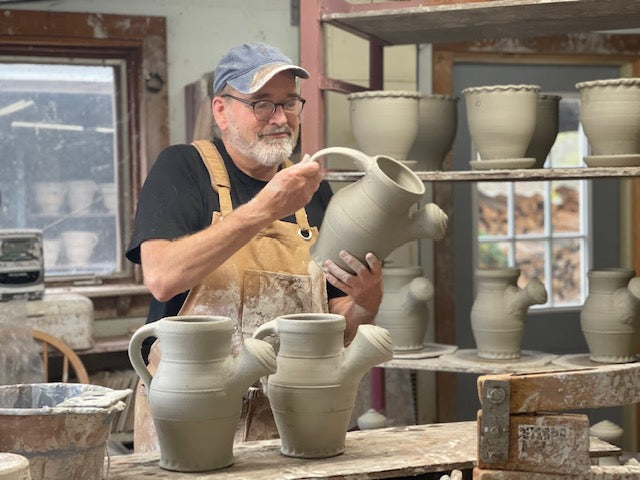
I've always been fascinated by old pottery, especially pieces that were made by country potters, for everyday utilitarian purposes. In 1996, my friend and fellow potter, Guy Wolff introduced me to the wonderful world of garden pottery. We had both been influenced over the years by early American salt-glazed pottery, 18th and 19th century English country pottery, as well as Korean and Japanese folk art, known as Mingei. But Guy opened my eyes to antique flower pots, garden tools and garden ornament. The book, Antiques From the Garden, by Alistair Morris became one of our favorite reference books when we were working to develop garden pottery for Smith & Hawken and other wholesale customers in the late '90's and early '00's. This is where I first saw one of these early English watering pots. The one shown below is from the Antiques in the Garden book, and is said to be from the 17th century.
These pots are a bit complicated and labor intensive to make, (I think of them as the garden potter's equivalent to making teapots). The first step is throwing the body of the pot, which is a traditional pitcher form, followed by throwing the spouts.











- They're an interesting puzzle to put together.
- I love the history behind them, and have so much admiration for the artisans who made them in earlier times.
- My customers really love them, and can't seem to find them anywhere else.
My thanks to all who have ordered these as part of the October Pre-Order selection, and whose orders allow me to keep doing what I love.


Comments
Lisa kenworthy
Beautiful! Saw you mentioned on Wyseguide
January 09, 2023
Rosalina
Love these. Any pictures of finished ones. Are they still available? Price. I live in Whidbey Island, Washington state.
January 09, 2023
Charlene Reese
Peter,
Hello, my name is Charlene Reese. I recently bought a number of your beautiful pots the other evening. I also have yours,Guy’s and Ben’s pots too. I love all of them. I signed up for your newsletter/information. But I’m not familiar with the preorder process. I would love to be included on preorders. I’m fascinated about the historical pottery. I’m a frequent visitor and donor to both Colonial Williamsburg and George Washington’s Mt. Vernon.
I’m not sure if you are aware of Martha Washington’s watering can looked like, it looks like the clay flowering pot you have on the website. I would love one of yours. Will you be making any of those in the future? I would love to reserve one.I can’t wait to see my new additions to my beautiful pots. Have you ever made a Maryland pot? Many years ago I bought some of Guy Wolff’s pots and I was told the one was a Maryland pot. I live in MD so I’m curious. Sorry this message is so long.🤣 I’m just so interested in your work.
Best to you. Glad to here your mom is getting better.
Sincerely,
Charlene Reese
January 09, 2023
Patricia Perry
I want to order one of the Old English watering pots. Can I order one on line or do I have to wait until you open up for pre-orders?
January 09, 2023
Patricia Perry
How would I be able to order one of your Old English Watering Pot, and please furnish your price.
Thank you so much.
January 09, 2023
Dianne
Can you tell me when you will be making the old english watering pot, and give me pricing info, etc? Thank you very much.
January 09, 2023
Jackie Mooney
I love these watering pots.. So quaint!
January 09, 2023
Roz Burciar
Thank you so much, Peter, for all your beautiful work & for the history behind all the pieces I hope my children & grandchildren will cherish them as much as I do.
January 09, 2023
Laura Boissonnault
Just love reading about your connection to the pieces and hearing about the process. Can’t wait to add this to my collection. It’s a beauty, Peter!
January 09, 2023
Leave a comment
Also in Blog Posts
Patina on Terracotta Flowerpots
By Peter Wakefield Jackson January 13, 2023 1 Comment
Continue reading
Centering Made Simple
By Peter Wakefield Jackson February 12, 2021 1 Comment
Continue reading
Flowerpot Friday - 19th Century English Horticultural Terracotta
By Peter Wakefield Jackson February 05, 2021 1 Comment
Continue reading